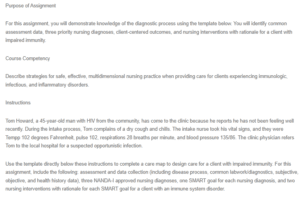System Care Map-Impaired Immune System
| Assessment
and Data Collection |
Three NANDA-I Approved Nursing Diagnosis | One Smart Goal for EACH Nursing Diagnosis | Two Nursing Interventions with Rationale for EACH Nursing Diagnosis |
| Disease Process:
HIV-positive patients have a damaged immune system, increasing their risk of opportunistic infection. The risk of opportunistic infection is decreased by compliance with antiretroviral therapy and preventive medications such as co-trimoxazole. A patient’s lifestyle and nutrition also dictate the occurrence of opportunistic infections such as cough (Justiz & Naik, 2022). Common Labwork/Diagnostics: ELISA test CD4+ T-cell count Viral load Liver function test Thyroid function test Assessment Data (consider subjective, objective, and health history): Subjective data: Current medications, social history, general and respiratory system review. Objective data: Physical examination, vital signs, and respiratory assessment.
|
Nursing Diagnosis:
Infection-related to HIV, as evidenced by the patient complaining they have not been feeling well lately and have a dry cough.
Nursing Diagnosis: Hyperthermia related to HIV infection, as evidenced by the patient’s temperature of 102 degrees Fahrenheit, pulse rate of 102 beats per minute, and respiratory rate of 28 breaths per minute.
Nursing Diagnosis Anxiety related to a new situation, as evidenced by the patient’s complaints of dry cough, chilling, and feeling unwell. |
SMART Goal:
To prevent progression and treat existing infections (Justiz & Naik, 2022).
SMART Goal: To stabilize the patient’s temperature back to the normal range within at least four hours of admission (Justiz & Naik, 2022).
SMART Goal: To reduce the patient’s anxiety level. |
1. Ensure the patient is compliant with their antiretroviral therapy. Test the patient’s CD4 T-cell count to monitor response to antiretroviral therapy in cases where the patient is compliant. Antiretroviral therapy prevents HIV complications such as infections (Kemnic & Gulick, 2022).
2. Ensure symptomatic relief by treating the patient’s symptoms, such as dry cough. 1. Adjust the room temperature and advise the patient to remove excess clothing to improve the patient’s comfort and regulate temperature (Nguyen et al., 2022). 2. Use antipyretics and a tepid sponge bath to decrease fever and cool down the body.
1. Assess the patient’s anxiety level to determine the appropriate way to approach them.
2. Educate the patient on HIV and opportunistic infections. Patients who understand their situation are calmer and experience less anxiety (Ong et al., 2022).
|
References
Justiz Vaillant, A.A., & Naik, R. (2022). HIV-1 Associated Opportunistic Infections. StatPearls Publishing. https://www.ncbi.nlm.nih.gov/books/NBK539787/
Kemnic, T.R., & Gulick, P.G. (2022). HIV Antiretroviral Therapy. Treasure Island (FL): StatPearls Publishing. https://www.ncbi.nlm.nih.gov/books/NBK513308/
Nguyen, T. K., Nguyen, Y. H., Nguyen, H. T., Khong, Q. M., & Tran, N. K. (2022). Etiologies of fever of unknown origin in HIV/AIDS patients, Hanoi, Vietnam. BMC infectious diseases, 22(1), 61. https://doi.org/10.1186/s12879-022-07049-3
Ong, J. Y., Yee, A., Amer Nordin, A. S., Danaee, M., & Azwa, R. I. (2022). The prevalence of depression, anxiety, and associated factors among adults with living human immunodeficiency virus in University Malaya Medical Centre. International journal STD & AIDS, 33(10), 880–889. https://doi.org/10.1177/09564624221106528
ORDER A PLAGIARISM-FREE PAPER HERE
We’ll write everything from scratch
Question
Purpose of Assignment
For this assignment, you will demonstrate knowledge of the diagnostic process using the template below. You will identify common assessment data, three priority nursing diagnoses, client-centered outcomes, and nursing interventions with rationale for a client with impaired immunity.

System Care Map-Impaired Immune System
Course Competency
Describe strategies for safe, effective, multidimensional nursing practice when providing care for clients experiencing immunologic, infectious, and inflammatory disorders.
Instructions
Tom Howard, a 45-year-old man with HIV from the community, has come to the clinic because he reports he has not been feeling well recently. During the intake process, Tom complains of a dry cough and chills. The intake nurse took his vital signs, and they were Tempp 102 degrees Fahrenheit, pulse 102, respirations 28 breaths per minute, and blood pressure 135/86. The clinic physician refers Tom to the local hospital for a suspected opportunistic infection.
Use the template directly below these instructions to complete a care map to design care for a client with impaired immunity. For this assignment, include the following: assessment and data collection (including disease process, common labwork/diagnostics, subjective, objective, and health history data), three NANDA-I approved nursing diagnoses, one SMART goal for each nursing diagnosis, and two nursing interventions with rationale for each SMART goal for a client with an immune system disorder.

